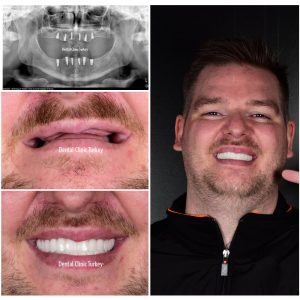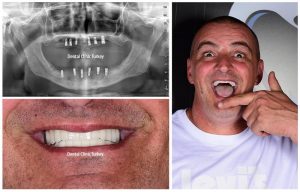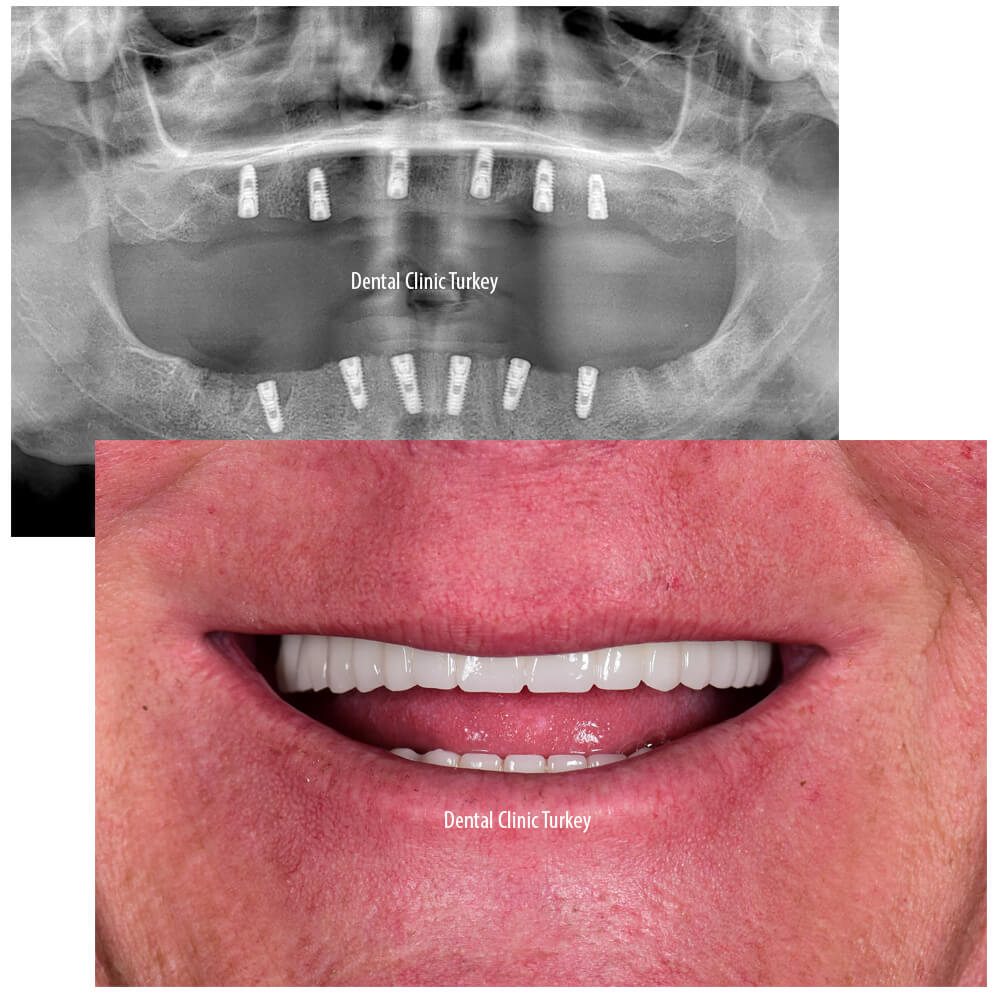Full Mouth Implants
Tooth loss can occur in the mouth for many different reasons. As tooth loss increases, the mouth cannot perform its necessary functions. As a result, toothlessness occurs. The treatment of many tooth loss in the mouth is also called full mouth implant treatment. Full mouth implant treatment is planned to make a maximum of 6 pieces in the lower jaw and a maximum of 6-8 pieces in the upper jaw.
What is Full Mouth Implants treatment?
It is the treatment of jaws with implants and bridges on implants in case of complete edentulism or when all teeth need to be extracted for certain reasons.
How is Complete Toothlessness Treated?
It is treated in the form of fixed or removable implant-supported prosthesis applications in cases of complete edentulism. Today, the desire of almost every individual with a fully edentulous jaw is to have fixed (non-removable) prostheses.
How many implants are made in the Full Mouth Implants treatment?
First of all, the first thing to know is that for such a treatment application, the bone level must be of good quality and the anatomical conditions must be suitable for this procedure. The type of prosthesis to be used while preparing the teeth on the implant is the determining factor in the type of treatment to be applied. A removable prosthesis or overdenture can be made on 2 or 4 implants.
For a fixed bridge in fully edentulous jaws, at least 6 more ideally 8 implants are applied.
Again, it has become a frequently applied method in recent years to choose all on 4 implant treatment in which 4 implants are applied in complete edentulousness.
Implants Can Be Applied to Everyone
Implant applications can be made to anyone with a good general health condition. Implants can be applied to people who have systemic diseases such as heart, diabetes and blood pressure and who need to use drugs continuously, provided that the drugs are correctly examined by the patient’s doctor and antibiotic protection is applied if necessary. However, in very young patients with incomplete bone development; implantation should be delayed until the completion of bone development.
Success in Implant Application
There are two important pillars of success in implant application. Using patented products in international standards that have proven their success with long-term clinical results and applied by a well-trained and experienced physician. In cases where these two important factors come together, full mouth implant is the easiest solution to toothlessness.
When making an implant, you should first be sure of the material used. This can only be understood by questioning the patent and certificate of the dental implant. The second rule of having a healthy implant is to prefer experienced specialists who have completed their training on this subject. The implant has been on our agenda for about 10-15 years, and finding the right specialist is as important as finding the right product.

How is Full Mouth Implant Treatment Applied?
First of all, it is examined by oral and maxillofacial surgery and treatment planning is carried out. In the first examination, the patient’s intraoral condition, bone structure and bone condition are observed. If the person’s oral condition and bone structure are suitable for the implant, treatment is started.
In patients with jaw bone resorption, the bone dose procedure known as sinus lift application is performed first and implant treatment is started after 6 months. People with heart, diabetes, blood pressure and chronic diseases are primarily processed after getting approval from their physicians. Then, with local anesthesia, the process of placing the implant in the bone is started. In order to place the implant in the bone, the gaps are opened and after the implants are placed in the opened gaps, they are closed by suturing.
The healing period of the implants is 3 months. After 3 months, the screws of the implants are opened and an impression is taken for the prosthesis. In line with the measurements taken, the prostheses are placed on the implants and the process ends.
Advantages of Full Mouth Implants Treatment
Full mouth implant treatment improves the quality of life of people by eliminating the missing teeth. It helps to fulfill the functions of eating, drinking and speaking. It creates an aesthetic appearance and also helps to improve facial appearance. It is a more comfortable form of treatment as there are no risk factors such as dislocation. It is also a very effective treatment in terms of endurance. It affects people’s business and social lives positively.
Disadvantages of Full Mouth Implants Treatment
It may appear to be disadvantageous because it requires a costly and long process. However, as a result of the satisfaction feedback received from the people after the treatment, these situations can be seen as a disadvantage.
How Long Is Full Mouth Implant Treatments Used?
Full mouth implant treatment has a lifetime use. Our clinic gives a guarantee to its patients against any problems related to the treatment.
Who Can Be Applied to Full Mouth Implants Treatment?
Over time, different complications may develop in the teeth. As a result of developing complications, people suffer tooth loss. Full mouth implant treatment is recommended for people who have problems due to excessive tooth loss.
Considerations for Full Mouth Implants
Considering the advantages it will provide to the patient in the case of total edentulism, the first goal is naturally, it is much more appropriate to apply such cases with a fixed restoration on the implant. However, some factors in some cases of total edentulism do not make it possible to apply those cases with a fixed restoration. There are factors for the mouth and teeth that determine whether a case of total edentulism can be restored.
The lower smile line, the appearance of many teeth from the outside of the mouth, and the fact that facial support is not necessary for the patient facilitates the decision for fixed restoration in terms of extraoral parameters.
Number and Selection of Implants
 Implant planning in total edentulism, in order to make implant supported fixed teeth, during the treatment planning, it must be determined in advance what the teeth will look like at the end of the treatment. It is possible to have enough information on this subject with the records taken from the patient, the diagnostic models obtained and the wax models to be made on them.
Implant planning in total edentulism, in order to make implant supported fixed teeth, during the treatment planning, it must be determined in advance what the teeth will look like at the end of the treatment. It is possible to have enough information on this subject with the records taken from the patient, the diagnostic models obtained and the wax models to be made on them.
While this procedure is important for planning, it also provides the clinician with very important guidance on how to position the implants during surgery.
In total edentulism in both the lower and upper jaws, when implant-supported fixed teeth are made, 6 or 8 implants are used depending on the size of the jaw structure. While 6 is sufficient for very small jaws, it would be a more appropriate approach to use 8 implants in normal or larger structures.
The increase in the number of implants, in addition to the advantages it brings, allows the final restoration to be made in smaller sections. In cases where 6 implants are used, the restoration is made in 2 parts at most, while in cases where 8 implants are used, the restoration can be divided into 4 parts.
Grafting
The tooth is an important structure that holds the jawbone together. If long-term implant treatment is not performed after the tooth is lost, bone loss will occur in that area. Since the implant cannot be placed in case of bone loss, the bone must be enlarged in the area where the implant will be placed. For this reason, having an implant immediately after tooth loss has a positive effect on implant treatment prices.
For similar reasons, artificial bone powder (bone graft) is used in the area where the implant will be made, in cases where the bone structure, size, level and density of the bone are insufficient. Graft, membrane and tissue adhesives imported from abroad are expensive materials and are factors that increase the cost of implant treatment. In addition, due to the bone structure, the necessity of using implants with improved surface properties and produced with higher technology will increase the treatment fees.
CONCLUSION
Despite all its complexity and difficulties, implant and prosthesis in completely toothless cases, error-free diagnosis and treatment planning, and implant-supported whole mouth fixed rehabilitation provide great benefits in terms of bone resorption as well as many advantages such as comfort in functional, aesthetic and social life for patients.
Frequently Asked Questions
How long does the implant tooth placement process take?
It is a process that takes between 30-60 minutes on average, depending on the area to be placed and the number of implant teeth.
What can I eat after the implant tooth is placed?
Your dentist will advise you on a soft foods diet for a few days following the operation.
How long is the total treatment period with the placement of the implant tooth, the healing period and the making of the prosthesis?
It can vary between 3-6 months depending on the treatment plan.
What is my role in Dental Implant care?
Brushing and flossing include home treatments, but you should visit the dentist regularly.
How long is the life of implant teeth?
If used and cared for properly, your implants will serve you for more than 40 years or a lifetime. All implants used in our clinic are EU branded and CE certified and have a lifetime warranty.
What happens if the implant fails to fuse with the tooth and bone?
The implant is removed from the place where it is located and that area is expected to heal. After sufficient time, if the existing bone is suitable, another implant is placed in that area.
What will I do if there is a problem with my implant teeth?
The implants we apply are of the quality that are known in Europe and that many dentists can reach the implant key.
To get information about full mouth implant treatments, you can call us, fill out our consutlation form or send a message directly via Whatsapp.

